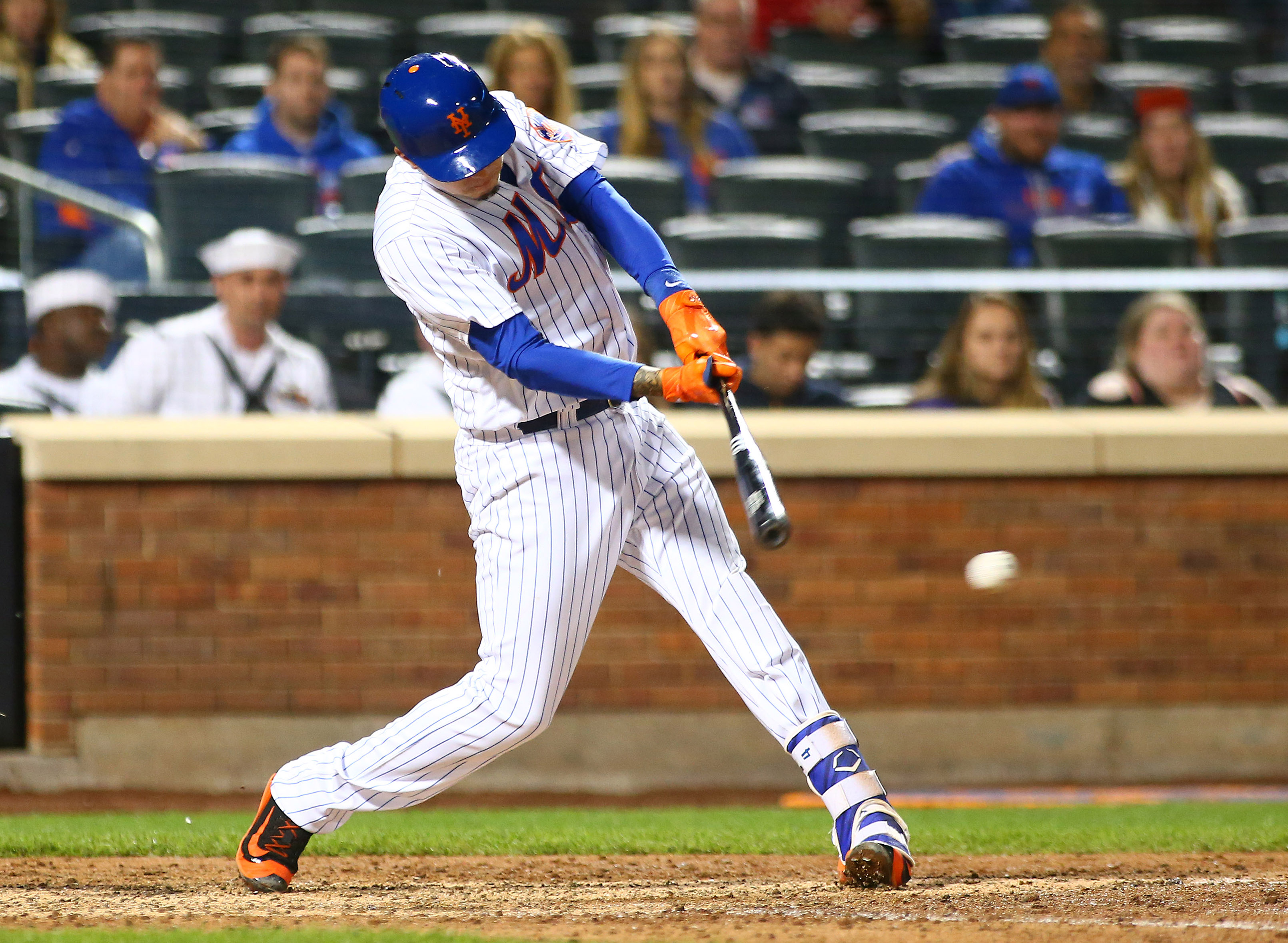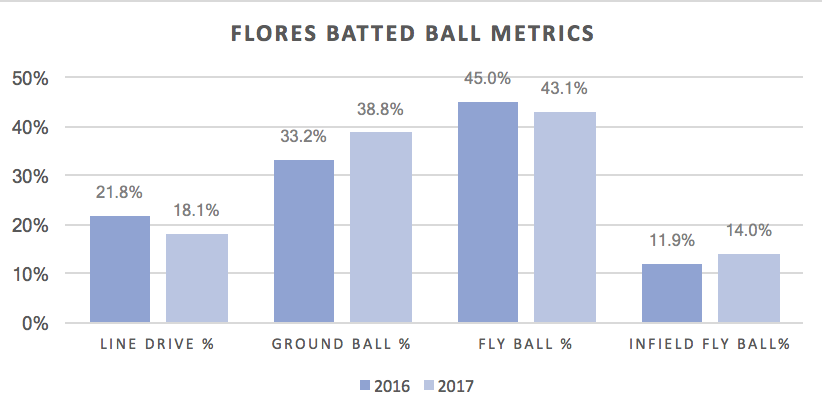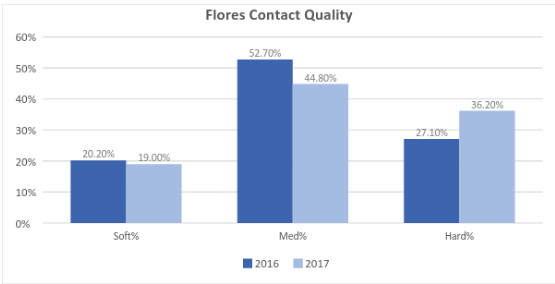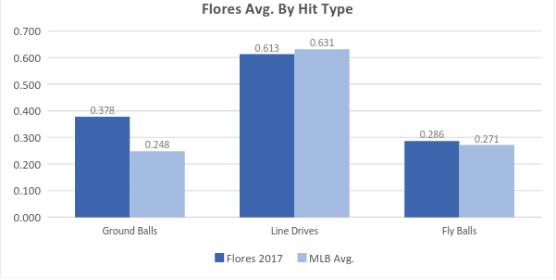It’s sometimes hard to fathom how many ups and downs Wilmer Flores has experienced over his brief career. From utility man Flores to crying Flores to (almost) Milwaukee Brewer Flores to World Series shortstop Flores and back to utility man Flores, Wilmer has never had much stability in his role.
Heading into 2017, the 25-year-old infielder was ticketed yet again for the bench and expected to contribute mostly against left-handed pitching. Injuries to David Wright and Asdrubal Cabrera opened up just enough playing time for Flores to sneak into the lineup, and his ensuing offensive breakout has since relegated Jose Reyes to the bench.
Flores has always been considered a bat-first, glove-second player who can mash lefties. In 2016, he led the league with a .710 SLG against southpaws, but only posted a .353 mark against righties. Come 2017, well, things have changed quite a bit.
Flores is currently slashing a career high .317/.344/.488 with a 0.9 BWARP that sandwiches him in the Mets rankings between Lucas Duda and Yoenis Cespedes. Over the last 30 days, he’s been among the best players in baseball, batting .391 with a 173 wRC+ that puts him ahead of players like Jose Altuve and Anthony Rizzo. Yes, we’re dealing with some small sample sizes here, but it’s also possible we’re dealing with a new Wilmer Flores.
At first glance, many of Flores’ underlying statistics look the same (if not worse) than previously. He’s striking out at an almost identical rate to last year, walking less, and not hitting the ball much harder than before. His average exit velocity in 2016 was 86.3 mph, up to just 87.0 mph in 2017. While he’s distributing the ball to all fields at the same rate as last season, those types of batted balls seem to have changed a bit.
From the looks of it, Flores is trading out line drives and fly balls for popups and grounders. On the surface, it’s not too sound of strategy, considering Flores isn’t quite the fleetest of foot. In case you need a reminder, this is what he looks like laboring around the bases:
It’s not pretty. How, then, is Flores experiencing this much success despite putting the ball on the ground almost 40% of the time? They say a pitcher’s best friend is a ground ball double play, but what’s a hitter’s best friend? In Wilmer Flores’ case, it’s most certainly batting average on balls in play.
Flores’ BABIP has skyrocketed from .268 to .360 this year, which is well above the league average of .296. Essentially, Flores has been hitting ‘em where they ain’t and reaping the benefits of it. The problem is, this isn’t usually a sustainable skill for players of Flores’ ilk. A high BABIP is typically associated with a player getting lucky, and that luck is likely to run out sooner or later. Consider this video as a perfect example of Flores’ luck this season.
That RBI single was struck at 55.5 mph. Yes, just 55.5 mph. It literally could have rolled along an interstate highway without being ticketed for speeding. Wilmer doesn’t care about that, though, because he ended up on first. These types of hits won’t last for Flores, but it’s not as though every ball off his bat barely rolls into the outfield. In fact, he’s making hard contact more than ever.
Despite an almost identical average exit velocity, Flores has bumped up his hard% by 10 percentage points. Knowing what we know about averages, that must mean he’s been hitting hard balls harder and soft balls softer. Tom Tango at MLB.com recently demonstrated that wOBA, a statistic designed to capture a player’s offensive performance per plate appearance, increases dramatically beginning at an exit velocity of 95 mph.
This season, Flores has recorded an exit velocity greater than 95 mph in 37.1% of his batted balls. That’s not great, but it is a substantial improvement over his 28.6% mark in 2016. However, those hard-hit balls haven’t translated into power, but rather batting average. Let’s take a closer look at how that’s transpired, focusing again on batted ball types.
It all comes back to ground balls. Pretty much everything else is in line with MLB averages, but Wilmer’s having much more success hitting the ball on the ground. His .378 average on ground balls is tenth best in the majors, trailing noted speedsters like Jean Segura and Delino DeShields.
Putting it all together, we’ve come to two main conclusions:
- Flores is hitting more balls really hard
- Flores is hitting more ground balls
The fly ball revolution is in full bloom these days as home runs reach peak numbers. The main premise behind this revolution is hitting the ball hard in the air. Flores, on the other hand, seems to have gone in the opposite direction.
I’ll take a moment to explain this table because there’s a lot packed in there. First, Flores’ grounders are almost 1.5 mph faster than the average MLB grounder. As a result, his ground ball xwOBA, a statistic based on exit velocity and launch angle designed to represent deserved wOBA, is up at .259. Going back to the premise of really well-struck balls, more than 35% of his grounders are hit harder than 95 mph.
Putting all of that together, we have a much better explanation than “luck” as to why Flores is experiencing so much success with his BABIP. Even after all of that, though, there’s still a major discrepancy between Flores’ .563 batting average on grounders hit at least 95 mph and the .431 MLB average. That, my friends, is luck, and it’s the reason players show up at the park to play the games on the field instead of playing them on paper.
Photo credit: Andy Marlin – USA Today Sports





Very nice explanation of Wilmer’s recent success. It will be interesting to see if teams position their infielders any differently against Flores.
By the way, sometimes this site crashes after a couple of minutes on a post. It seems to be Flash related, probably in an ad, as it doesn’t happen in the Edge browser when Flash is blocked.
Much appreciated. I took a look at his spray charts, and aside from a slight tendency to pull the ball, there isn’t great reason to put on any sort of shift against him.
Thanks for the notice about the site difficulties. We will look into them.